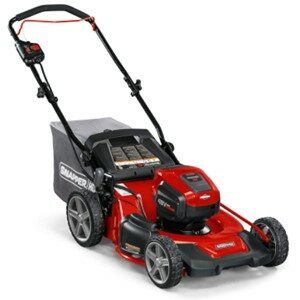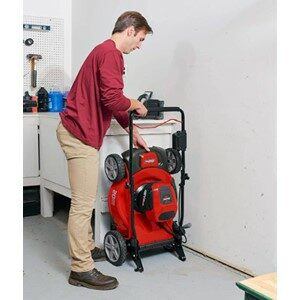Snapper’s Mower Blades Makes A Difference!
1) History of Snapper.
2) Snapper Lawn Mower Maintenance.
3) What To Look For When Replacing The Blade?
4) Best Lawn Mower Features.
The Snapper lawn mower models are made in America using high-quality materials. Their cutting method is unique as it snaps as the grass rather than slice it. This is different from their competitor’s lawn mowers in the way the grass is being cut. Lawnmower blades are unique to the brand that makes the mower. You cannot interchange them with other mowers. You must purchase blades for the brand of mower you own.
They now make all types of mowers including gas push, self-propelled, battery, electric, riding and zero-turn models. You should have to problem in finding a model that is best for your yard.
Snapper Lawn Mower History
The company was founded in McDonough, Georgia in 1894 as the Southern Saw Works. They added lawn mowers to their product line in the 1950’s.
In 1951, they launched their first lawn mower as the Snapping Turtle.
In 1967, their lawn mower sales grew to $10 million annually.
In 1987, their sales grew to over $260 million and were ripe for a takeover.
In 2002, Simplicity bought the Snapper brand.
In 2004, Briggs & Stratton acquired Simplicity and took control of the Snapper brand.
In 2019, Briggs & Stratton filed for bankruptcy and KPS Capital Partners took over. They still produce Snapper mowers in Milwaukee and Munnsville, New York as of this writing. They also took over the production facilities in China. The company has not decided to make lawn mowers in those factories.
Today they make riding, zero-turn, electric, battery, and self-propelled models.
Snapper Riding Lawn Mower Maintenance
Standard maintenance should always be done to lawnmowers so they can last you for years to come. Below are some great tips on this maintenance.
- Clean your riding mower regularly. As you continue to mow grass, clipping twigs and moving leaves around the yard, some of these items can get into the mower. To keep your lawn mower in good running condition, after each mowing session check the deck and remove any debris and glass clippings. Also, remove any debris from under the mower’s deck. Some mowers have a handy wash-out port, to hook the garden hose to flush out the debris from under the deck. Use it.
- Lubricate the mower’s parts. To avoid wear and tear on the moving parts, lubricate the moving parts. You can use a grease gun to apply lubricant to the small moving parts. Check these parts regularly after each session. Lubricate as necessary.
- Change the air filter. After each mowing season, check the air filter. It just might be dirty. Remove the air filter and clean the surrounding area and replace it with a clean one.
- Replace the spark plug. After the mowing season is finished, you should replace the spark plug. Doing this will yield easier starts and better fuel economy. Be sure to correctly to adjust the gap between the electrodes. Refer to the owner’s manual for the proper gap.
- Check the mower’s belts. After each mowing season, you should check the mower’s belts for any wear or damage. You can replace worn out belts with a new one. Refer to the owner’s manual for the proper belt part replacement number.
- Check the oil regularly. The mower requires oil to run smoothly. Be sure to check the oil during the mowing season and be sure it is full before cutting. It is recommended that you change the oil after the season is over so it’s ready in the spring. Or, after every 50 hours of use whichever comes first. Follow the instructions in the owner’s manual for the correct oil type. Failure to change the oil causes the oil to become dirty and eventually breaks down. The oil loses is cooling agents which will cause damage to the engine.
- Remove excess fuel from the tank. Gas gets stale after days of no use. Before putting the mower away for storage, remove the fuel from the tank by 1). Draining the fuel, Or, 2). Let the engine run until all the fuel is used up and the motor shuts off. Then store the mower away for the next season.
- Replace the lawnmower blades every 2 years. It is highly recommended that you change the lawnmower blades every two years. You need sharpen the blades twice per season to keep the grass healthy or after 25 hours of use. Replace the blade after 4 sharpening’s. On average, mower blades will last about 100-200 hours under normal conditions. If you see dents, gouges, bent, or missing pieces on the blade, replace it. The size of the yard and how often you use the mower will play a role on how often the blades need to be sharpened or replaced.
What To Look for When Replacing the Blade?
- Unevenness of the grass after a mowing session.
- Torn or not neatly sliced grass.
- If the blade is bent or damaged.
- If the mower should hit a sharp object look at the blade for any chips and dents.
- If you should see any of these 4 reasons, it’s time to sharpen or replace the blade.
Tip: When sharpening the blade be sure to maintain the angle from the factory. Usually this angle is between 30 to 35 degrees. Always sharpen from the top side of the blades cutting edge. You don’t need to sharpen both sides of the blade. The average cost of having the blades sharpened by a professional is between 10 to 50 dollars.
Let’s recap.
At the end of the mowing season do:
- Change the oil
- Change the air filter
- Change the spark plug
- Check the condition of the blade
- Drain out the gas from the fuel tank
- Place fuel stabilizer in the stored fuel container so it will keep the gas fresh for up to 1 year.
By doing these maintenance steps you will extend the life of the mower.
Best Mower Features To Look For
As you go about seeking out a new lawn mower, there are some features you need to consider before deciding on which mower to buy. We will mention some of them below:
- Lawnmower Performance. This is most important as a mower will be used on different types of lawns. If you have sloppy or hilly terrain, be sure it can perform well under those conditions.
- Engine Size. A larger engine size can handle yard maintenance that has tall grass, wet grass, leaf mulching, and bagging. If you have a large area to mow, be sure it will do the job. If you are planning on using the mower for these jobs, be sure the engine has enough power to do the tasks.
- Is The Mower Comfortable? If you have a walk-behind mower you want it to be set at the right height for you. Check the height from the floor model on display.
- Buying A Mower Should Not Be Stressful. You don’t have to make it more difficult when you mower shop. Know the layout of your property, including terrain, hills and objects that the mower needs to cut and find a model that does the job best. Know which mower features you must have. You can prepare ahead of time and know which features would be potential show stoppers if they are not included. This will make selecting the mower a lot easier.
- Type of Mower. Know the type of mower your yard needs. A small yard, under 1/4 acre, an electric or battery powered mower can do the job. For larger lawns, a self-propelled mower can do the job. For 1 acre or more, a riding mower should be considered.
- Storage. The Snapper lawn mowers can be stored horizantally to save storage space.
Shop Snapper Lawn Mowers
You can shop for your mower by clicking on the link of interest. You will be taken to Amazon where you can place the lawnmower order. While there you can read the customer reviews and answered questions.
As an Amazon Associate I earn from qualifying purchases.
Besides the mowers below, we have included a blade balancing tool so you can be sure after sharpening the blade it is properly balanced before placing it back on the mower.

